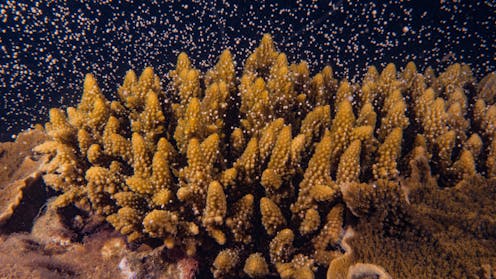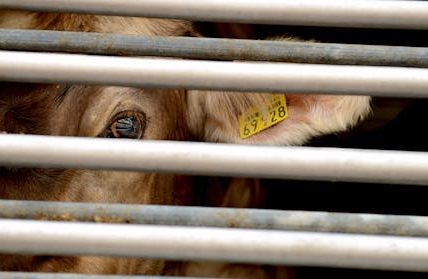The great coral reef relocation
An Acropora coral during a spawning event. Coral Brunner/Shutterstock
This article was first published in The Conversation’s Imagine email newsletter. Sign up to receive a weekly roundup of the academic research on climate action.
Underwater cities. Rainforests of the sea. Bulwarks against the ocean’s fury and sponsors of its bounty. Canaries in the coal mine that show how rapidly the once mild global climate is changing.
Tropical coral reefs encrust the coastlines of islands and continents near Earth’s equator but this zone, which has offered sufficient light and warmth for corals to evolve over hundreds of millions of years, is no longer hospitable.
The fourth global coral bleaching event is under way, thanks to unusually high ocean temperatures that have persisted since 2023. All of these events have happened in the last 30 years (2024-2025, 2014-2017, 2010 and 1998), hence the canary analogy.
Scientists have seized on an idea for saving reefs. What if corals can do as many other species are doing and migrate out of the boiling tropics?
What if we helped them move?
This roundup of The Conversation’s climate coverage comes from our award-winning weekly climate action newsletter. Every Wednesday, The Conversation’s environment editor writes Imagine, a short email that goes a little deeper into just one climate issue. Join the 45,000+ readers who’ve subscribed.
A quick biology lesson courtesy of Jörg Wiedenmann and Cecilia D’Angelo, ocean scientists at the University of Southampton. “Stony corals are soft-bodied animals made up of many individual polyps that live together as a colony,” they explain.
Corals that build reefs often share their calcium carbonate skeleton with tiny algae that photosynthesise like plants on land. The coral host gains food, the algae shelter. These algae are also responsible for the dazzling colour of reefs, but when conditions are too stressful – like during the ongoing marine heatwave – the algae depart and leave a bleached-white reef behind.
The reef will die if conditions remain poor for too long.
Going with the flow
“While adult corals build solid structures that are firmly attached to the sea floor, baby corals are not confined to their reefs,” says Noam Vogt-Vincent, a
postdoctoral fellow in marine biology at the University of Hawaii.
These intrepid larvae carry with them the fate of their home, and one of Earth’s most wildlife-rich habitats. They can travel hundreds of miles before settling in a new location. This is what allows the distribution of corals to shift over time, and the fossil record shows coral reef expansions have happened before, Vogt-Vincent notes.
Where larvae go is largely determined by ocean currents.
“Major ocean currents can carry baby corals to temperate seas. If new coral reefs form there as the waters warm, these areas might act as refuges for tropical corals, reducing the corals’ risk of extinction,” he says.
Suitable water temperatures for coral are expected to expand outwards from the tropics by 25 miles (40km) per decade. So, if waters are warming in the subtropics and temperate seas to accommodate them, could a tropical coral exodus be the answer?
To find out, Vogt-Vincent combined field and lab data on the conditions corals need to thrive with data on ocean currents. He and his colleagues created a global simulation to represent how corals are likely to respond to changing environmental conditions, and then added future climate projections.
“We found that it will take centuries for coral reefs to shift away from the tropics. This is far too slow for temperate seas to save tropical coral species – they are facing severe threats right now and in the coming decades,” he says.
A helping hand
Could people expedite this migration and help corals to settle and thrive on new patches of seabed? This has been tried to some success before.
South Sulawesi in Indonesia once hosted some of the world’s most vibrant and diverse coral reefs. They were decimated by dynamite fishing in the 1990s. However, divers working for the Mars coral restoration programme at Pulau Bontosua have kickstarted their recovery by transplanting healthy coral fragments into the sea by hand.
Read more:
Restored coral reefs can grow as fast as healthy reefs after just four years – new study
When a marine heatwave struck the water south of Florida in July 2023, a heroic effort was launched to move young corals out of harm’s way. These included the fragments of coral kept and nurtured in artificial “nurseries” for transplantation on reefs.
“Divers have been in the water every day, collecting thousands of corals from ocean nurseries along the Florida Keys reef tract and moving them to cooler water and into giant tanks on land,” said Michael Childress, a Clemson University coral scientist.
Sadly, Vogt-Vincent is doubtful.
“Our research suggests that coral range expansion is mainly limited by slower coral growth at higher latitudes, not by dispersal,” he says.
“Away from the equator, light intensity falls and temperature becomes more variable, reducing growth, and therefore the rate of range expansion, for many coral species.”
What’s more, there are already species of coral living in temperate seas.
“Establishing tropical corals within those ecosystems might disrupt existing species, so rapid expansions might not be a good thing in the first place,” Vogt-Vincent says.
His team’s simulation suggests coral populations could expand in a few locations, particularly in southern Australia. But the expected loss of coral (roughly 10 million acres, or 4 million hectares) dwarfs the expected gain (6,000 acres, or 2,400 hectares).
Coral reefs teeming with biodiversity are on the frontline of the climate crisis.
Olendro heikham/Shutterstock
There is another option that could drastically improve the outlook for tropical coral reefs. Perhaps you’ve already guessed it.
“Our study suggests that reducing emissions at a faster pace, in accordance with the Paris climate agreement, could cut the coral loss by half compared with current policies,” Vogt-Vincent says. “That could boost reef health for centuries to come.”
There is still hope for tropical coral reefs, but it depends on rapidly ending humanity’s reliance on fossil fuels for energy.


